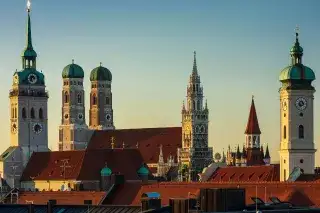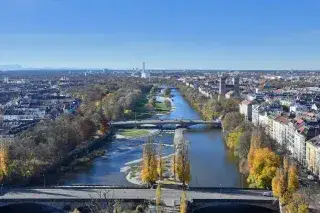Munich's most central fountain in front of the New City Hall
The Fischbrunnen on Marienplatz: A meeting point and landmark
The perfect meeting spot in Munich's city center: The Fischbrunnen (fish fountain) has been a fixture on Marienplatz for a long time. But the fountain is also famous for traditional events carried out in its water.
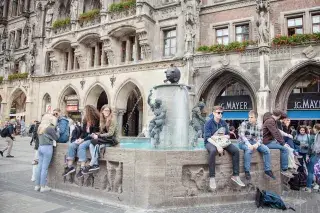
More actions
What you need to know about the Fischbrunnen
- The Fischbrunnen is a popular meeting place on Marienplatz directly in front of the New City Hall.
- It is also known for traditional events such as the annual Geldbeutelwaschen (wallet washing) and the so-called Metzgersprung (butcher's leap)
- The first Fischbrunnen was built between 1862 and 1865, but the fountain has only existed in its current form since 1954.
What the figures at the fountain mean
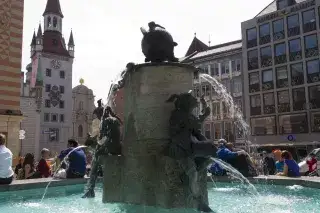
The fish fountain at the Marienplatz is a drawing well. The fountain water is not for drinking, but on hot days you can refresh yourself with it perfectly. The fountain in its current form consists of a turquoise-colored basin made of Nagelfluh (conglomerate rock from the northern foothills of the Alps), which makes the water shine so brightly. Around the central column stand the figures of three bronze butcher boys, pouring water into the basin from buckets.
On top of the column sits a bronze fish sculpture. It reminds us of the time when Marienplatz was home to a fish market, among other things. Today, when you look at the bottom of the fish fountain, you sometimes discover the odd cent piece, which is supposed to bring luck to the donor.
Washing the wallet - good luck for the entire year
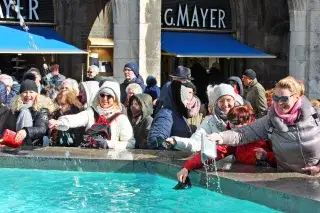
Another popular tradition for "good luck" is the so-called wallet washing. According to legend, it is said to ensure that one spends the rest of the year without financial worries. This tradition dates back to 1426 and was practiced on Ash Wednesday.
The simple people used this tradition to demonstrate to their employers that after celebrations or carnival the wallets were empty - and that a wage increase was necessary. In Munich, the event is revived every year, with the Lord Mayor or one of his deputies being present.
Metzgersprung (butchers jump): Baptism after the apprenticeship
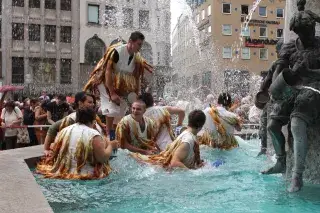
The Munich Butchers' Guild organises the Butchers' Jump every three years. It resembles a kind of baptism celebration the end of the apprenticeship.
In the past, butcher's apprentices dressed in sheep's clothing and marched through the streets to the Fischbrunnen. There they were acquitted from their apprenticeship and subsequently jumped into the water. For the grand finale they threw nuts at the spectators. Water has always been regarded as a purifying force, as it is for Munich's butchers, who have been reviving the old tradition of the butchers' jump every three years since 1995.
The tradition goes back to the plague, which caused fear and terror in Munich 450 years ago. Then the Schäffler (vessel makers) and butchers marched and danced through the streets with music playing. Nobody wanted to miss this funny spectacle. The Schäfflers dance and the butchers' jump are still reminders of the guilds' traditions today.
How the Fischbrunnen was constructed
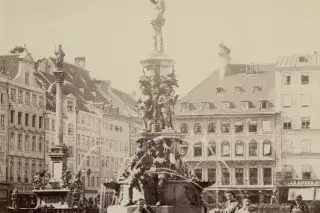
There has always been a fountain on the Marienplatz. The first one, whose location is no longer known exactly, was dated 1318. But it wasn't until the nineteenth century until the last predecessor was replaced by the Fish Fountain designed by the sculptor Konrad Knoll. The new fountain was completed between 1862 and 1865.
Knoll's fountain featured bronze water-spouting dolphins and lion heads. Four butcher's boys poured water out of buckets, four boys played music above them - and on top an old journeyman with a raised cup was installed.at their feet. During the Second World War the fountain was destroyed and rebuilt by Josef Henselmann in 1954. Among other things, he used the still preserved figures.
